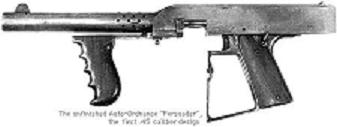Model 1919
Starting with the Serial no. 11, the Model 1919 takes the final appearance of the later Thompsons with the rear sights and butt stock. The Model 1919 was limited to about 40 units; the first built did not use the drums, as it was too difficult to fire. Many variations have been noted within this model. The weapons had very high cyclic rates up to 1,500 rpm.[30] This was the weapon Brigadier General Thompson demonstrated at Camp Perry in 1920. A number of Model 1919s were made without butt stocks, rear and front sights, but the final version closely resembled the later Model 1921. This model was designed to “sweep” trenches with bullets. The New York City Police Department was the largest purchaser of the M1919. Some experimental calibers aside from the standard .45 ACP (11.4x23mm) were the .22LR, .32 ACP, .38 ACP, and 9mm.[49]


Model 1923
The Model 1923 was a heavy submachine gun introduced to potentially expand the Auto-Ordnance product line and was demonstrated for the U.S. Army. It fired the more powerful .45 Remington–Thompson cartridge which fired a heavier 250 gr (0.57 oz; 16 g) bullet at muzzle velocities of about 1,450 ft/s (440 m/s) and energy about 1,170 ft⋅lb (1,590 J), with greater range than the .45 ACP. It introduced a horizontal forearm, improved inline stock for accuracy, 14 in (36 cm) barrel, bipod, and bayonet lug. The M1923 was intended to rival the M1918 Browning Automatic Rifle (BAR), with which the Army was already satisfied. The Army did not give the Model 1923 much consideration, so it was not adopted. In addition to the .45 Remington–Thompson, the M1923 Thompsons were to be made available to prospective buyers in several calibers, including .45 ACP, 9mm Parabellum, 9mm Mauser, and .351 Winchester Self-loading.[83]

Annihilator

Persuader
There were two main experimental models of the Thompson. The Persuader was a belt-fed version developed in 1917/18. It was partially built, but never completely finished. The Annihilator , serial no. Ver 10 prototypes were similar in appearance to the later models, but without the rear sight and butt stock mounts. The Annihilator prototypes in which box magazine adapters were present, were first were fed from a 20-round box magazine, but later, the 50- and 100-round drum magazine models were developed.

Auto Ordnance Prototype
Caliber: .30 short rifle M1 self-loading
Barrel Length: 10 inches
Overall length: 32 inches
Weight (unloaded): 10 to 12 pounds
Action: Blowback
Capacity: 20 round ![oZWnjj.jpg]

BSA M1926 Thompson Gun
in: Submachine guns
Thompson M1926
In 1923, Auto Ordnance entered their Thompson M1923 for French and Belgian military trials. While the French were quite unimpressed with the weapon, the Belgians liked it, but felt it should be chambered for 9x19mm Parabellum instead of .45 ACP, since 9mm ammunition was much more popular in Europe. Auto Ordnance did not have the manufacturing facilities to produce 9mm Thompsons, but they were rather desperate for a European purchase of their weapon, so they contacted Birmingham Small Arms in England to create licensed “European models”. The result was the so-called M1926, which differed from the original Thompson not only internally but externally too. The rate of fire was increased from 800 rounds per minute to 1200 rounds per minute. A major problem with this, however, was that the M1926 only accepted 20-round stick magazines, not drums, so the blistering rate of fire quickly depleted the ammunition in each mag. The M1926 was entered into French and Belgian military trials, with little success.








